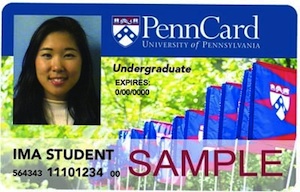U Penn Converts to Contactless ID Cards
- By Dian Schaffhauser
- 07/28/14
The University of Pennsylvania has formally begun moving away from ID cards that use a magnetic stripe and to cards with embedded chips. The replacement of cards will be done sooner than the replacement of card readers; that's expected to be completed for fall 2014. The university anticipates the entire migration away from the magnetic stripe to take a minimum of five to seven years.
The "contactless" technology uses radio frequency identification (RFID) and an antenna that enables data to be transmitted when the card is held within two to three inches of a card reader or tapped on the reader. The chip has capacity to store multiple applications and information.
According to a spokesperson for the university, the materials for the card are nonproprietary. The ID card uses an 8K MIFARE DESFire EV1 chip with a magnetic stripe option and a PVC card stock body.

Photo: Scott Spitzer, University Communications, University of Pennsylvania |
U Penn reported that the technology offers several benefits:
- Improved security;
- Faster transaction speed;
- The ability to integrate the PennCard for use in other systems; and
- More efficiency through standardization.
The new PennCards have been piloted at two locations, the Singh Center for Nanotechnology and Gregory College House. These sites were chosen, the institution told its community, "in part, because they represent two very different uses of the technology as it relates to building access allowing us to observe its use in a restricted research environment as well as a residential living situation."
The first use for the new cards will be to give people building access. The Division of Public Safety is developing a schedule for replacing all card readers used for this purpose, and that work is expected to be done by fall as well. The new readers will have a module to accommodate both magnetic stripes and contactless reading of cards to allow employees and students to continue using their magnetic cards until new ones have been issued to everybody.
"Right now, we use a magnetic stripe similar to those found on credit cards," says Chris Sapp, director of thePennCard Center. "The chip, however, is more secure and positions us well to offer other services through the PennCard in the future."
For example, the adoption of the new cards will one day allow students and staff to use their cards to get around the region. The Southeastern Pennsylvania Transportation Authority, which runs area rail, buses and trollies, expects to be finished adopting a new contactless payment technology by the end of 2015.
About the Author
Dian Schaffhauser is a former senior contributing editor for 1105 Media's education publications THE Journal, Campus Technology and Spaces4Learning.